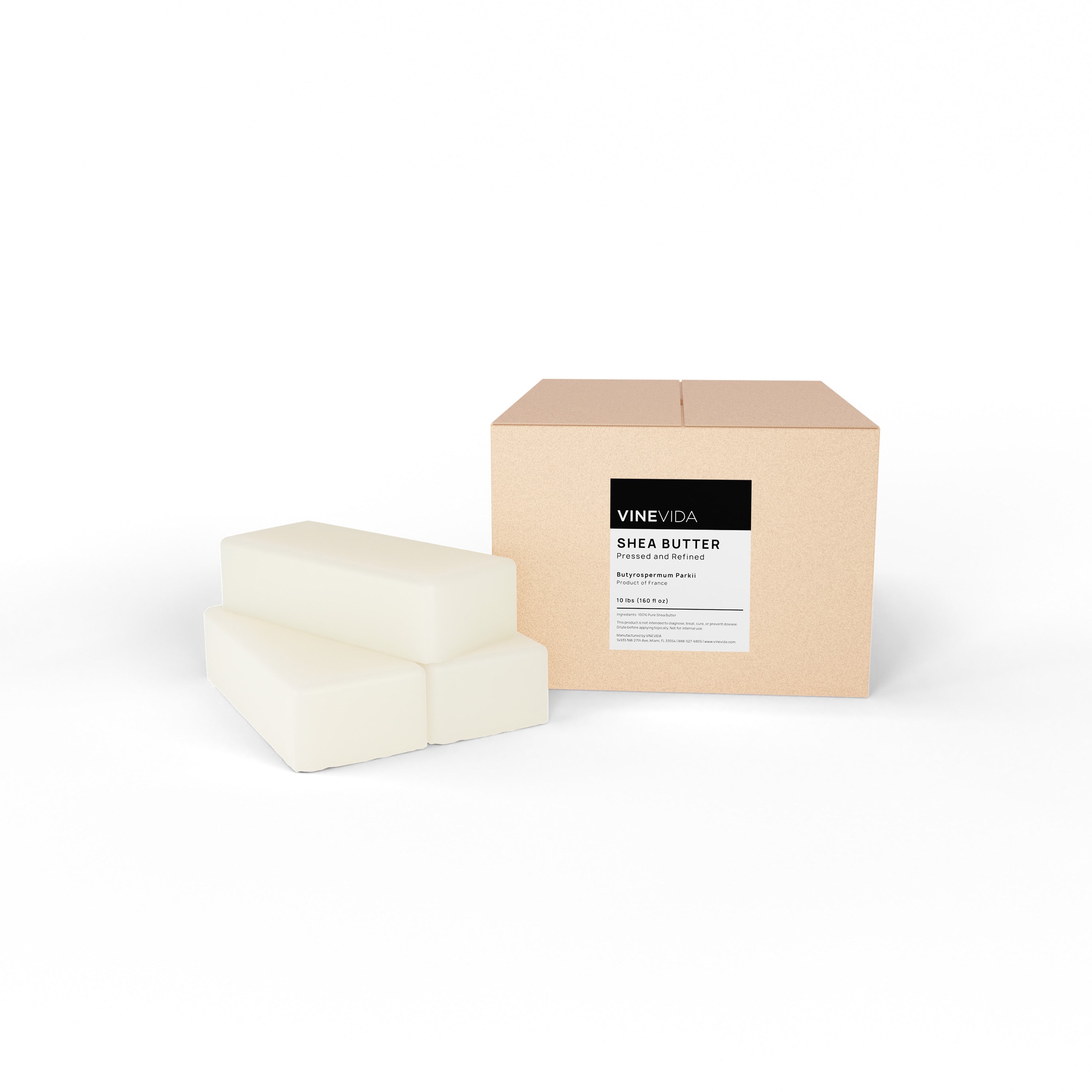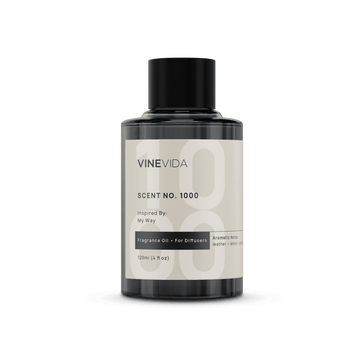What is Shea Butter?
Shea butter is extracted from the kernels of the shea tree's fruit that grows wild in the sub-Saharan areas. The superbly moisturizing properties of the nut have protected the skin and hair of the people from the burning sun. Now, it forms a vital source of empowerment for the women of the areas, as they collect the kernels, process them traditionally, and export them across the globe.
A butter is an oil that is solid at room temperature. Most body butter on the market is technically not since they contain water. True butters are anhydrous. Containing no water, this also means they don’t need emulsifiers (which you would otherwise use to make oil and water mix).
There are two types of shea butter - refined and unrefined.
Refined vs Unrefined Shea Butter
Unrefined shea is a kind of golden olive color and has a strong fragrance. It smells kind of nutty, earthy and almost smokey, which limits the kinds of essential oils that you can blend with it. Refining it removes the color and scent. Refined Shea Butter is white and fragrance free. It is an excellent moisturizer but has fewer skin regenerating benefits than unrefined Shea Butter. However, its blank fragrance and appearance makes it easier to add to more products and has a longer shelf life.
How do You Pronounce Shea Butter?
Let’s get this out of the way first because one of the main things that stop people from really sinking into the lusciousness that is shea is that they are worried about saying the name wrong.
The English word Shea - that rhymes with “Tea,” derives from the common name of the tree - shísu ߛ߭ߌ߭ߛߎ (lit. "shea tree"), which derives from the Bambara tongue spoken in Mali. However, the second pronunciation of rhyming with “Day” can also be found in dictionaries. Both versions are correct, but the first version is consistently cited as first, making it the more accepted use.
Where does Shea Butter Come From?
Shea grows prolifically across the dry savannah belt of West Africa from Sudan in the East to Senegal in the west. It flourishes in the foothills of the Ethiopian highlands.
Growing naturally in 21 countries across the African continent, no one has been successful in cultivating it. It brings crucial money to Benin, Burkina Faso, Cameroon, Central African Republic, Chad, Ethiopia, Eritrea, Ghana, Guinea Bissau, Ivory Coast, Mali, Niger, Nigeria, Senegal, Sierra Leone, South Sudan, Sudan, Togo, Uganda, the Democratic Republic of the Congo, Kenya, and Guinea.
Trees flower in late December, and early January, then come to full fruition around April. The fruits- that spoil quickly - fall to the ground and are snaffled promptly by insects and wildlife. Very few people have ever tasted the dry-sweetness of the fruit since they deteriorate almost as soon as they are formed.
Extraction Method of Unrefined Shea
The area's women collect fallen husks and take them home to dry. The kernels are boiled to remove all remaining husks and to sterilize the nuts, then turned onto the concrete ground to dry in the sun. At all points, the women must be vigilant about the weather since the rains come fast, with minimal warning. Getting them wet at this stage can spoil the butter, so they can be taken in and outside for three or four days as they dodge the rain.
After two more washings, the kernels are ready to be roasted on an open fire. Roasting releases the oils that make the vital butter. Then, they are pounded and crushed to release their oils. However, the oil is now full of particulates and is a dark cocoa brown color.
Now comes incredibly physical work.
The butter is placed into water to knead it. They mix, and the oil starts to solidify and rises to the top to be separated from the fluid. The pulverised shea creates a white bloom on the surface of the water. As the oil solidifies and rises, it is transferred to another pot to be kneaded more until the beautifully thick and creamy butter eventually starts to form. From there, the butter is packaged and exported worldwide, just as it has been since the dawn of history. There may be evidence that Egyptian queen Nefertiti kept her skin smooth and beautiful with shea.
Refinement Technique for Shea Butter
Refined shea is extracted using a high heat, n-hexane chemical process that removes impurities, color and fragrance.
In hexane extraction, the ground seed is mixed with hexane which allows the seed’s fatty constituents to dissolve in the hexane. The resulting liquid is then separated from the seed residue and treated to remove the hexane and leave behind crude Shea Butter.
The crude Shea Butter is then degummed; neutralized, centrifuged and then washed in hot water to remove any free fatty acids. It is then bleached and filtered to remove pigments and trace metals.
Clearly, because heat has been used, this can no longer be called Raw Shea Butter.
Why is Shea Butter So Good for Skin and Hair?
Shea butter extract contains oleic acid (40–60%), stearic acid (20–50%), linoleic acid (3–11%), palmitic acid (2–9%), linolenic acid (<1%), and arachidic acid (<1%).[10]. It also contains vitamins A, E, and F.
Oleic Acid
Oleic acid calms, balances, and repairs the skin. It has anti-inflammatory properties proven to stimulate wound healing, making it very useful for conditions like eczema, rosacea, and psoriasis. Oils and butter high in oleic acid are found to be the best at repairing and protecting the natural skin barrier. (Vaughn, 2018)(Poljšak, 2020)
Stearic Acid
Stearic acid is an emollient and lubricant that softens skin. It protects the skin's surface against water loss, fortifies its protective barrier, and has texture-enhancing properties. It is a natural emulsifier, which is useful when making products because it prevents them from separating.
Palmitic Acid
Again, moisturizing.
Linoleic Acid
Also known as Vitamin F, an omega-6 chain fatty acid is one of two essential acids in shea. Essential acids are components the body cannot make naturally, so they must be ingested to enter the bloody system. They are significant for skin health, especially for conditions like eczema and psoriasis.
When used topically, Linoleic acid moisturizes and “plumps” the skin without weighing it down. Fortifying and protecting its barrier, it fends off UV rays and air pollutants like smoke. However, we should stress that it does not offer SPF protection.
Linolenic Acid
The second essential fatty acid job is as a skin conditioning and healthy ingredient with soothing properties.
Raw Shea Butter is Also High in
Vitamin A
Excellent for balancing skin color and reducing hyperpigmentation. It improves the appearance of the skin and prevents sagging.
Vitamin E
Nourishes and protects the skin and has powerful antioxidant abilities.
However, sadly, these are removed in the refining process and so are not found in Refined Shea Butter
Cautions for Using Shea Butter:
There are two sets of people who should be careful using shea butter.
Since it is extracted from a kernel, it may cause harm to people with nut allergies.
Shea butter and cocoa butter contain a natural latex/protein that people with TYPE B Latex allergies may react to.
Recommended Usage of She Butter
Predominantly, shea butter is used for its moisturizing and protective qualities. It locks in moisture and smoothes the skin surface. It is beautiful for chapped, dry, sore complexions where the skin has become ragged. In addition, it is excellent for hair that has gone dry and frizzy.
Creams rich in shea butter are lovely for chapped skin and cracked heels.
It also makes a beautiful conditioner for dry, frizzy, and damaged hair.
It melts at body temperature, instantly absorbing into the skin, adding valuable lipids to cell structure.
If we think of skin cells as building bricks that are held together with mortar, that mortar is lipids - better known as fats. When the lipids break down, the skin becomes brittle and flaky.
Shea Butter is excellent for soaps, lotions, and creams.
Shelf Life of Shea Butter
Refining extends the shelf life of Shea Butter
Unrefined Shea will last around 24 months
Refined shea is much more stable lasting 37 months +
Storing Shea Butter
Excessive heat melts shea butter and makes it decay faster. Keep your shea in a cool dark place. A refrigerator is ideal.
Applications for Shea Butter
Balms: 5 – 100 % of total product
Lotions & Creams: 2 - 20 % of total product
Soaps: 5 - 20 % of total product. Has a saponification value of 170. It makes a hard soap with a creamy lather.
Hair Conditioners: 1 – 10 % of total product
Its melting point ranges from 32°C to 35°C.
How to Make Whipped Shea Butter
A whipped shea butter comprises a minimum of 55% combined with other carrier oils.
There are two keys to making whipped shea butter. The first is to ensure you melt the butter. Unmelted shea tends to go lumpy. To combine it well, melt it slowly into the other oils in a double boiler. Place a bowl over warm water and allow it to melt slowly.
The following key is to whip the cooled oils slowly. Do not whisk it fast, or you’ll add too much air into the mix.
It is always easier to make an immense amount of cream than to fiddle with little bits.
Whipped Shea Butter Recipe
This should make 42 oz (1200g) of finished product filling 12 4oz jars, loosely filled. We’ve used rosehip oil here, but any vegetable oil with a light consistency will work well. Have fun and experiment.
Strictly speaking, since it is an anhydrous product, it doesn’t actually need a preservative, but we have added one here for the belt and braces. The starch simply helps to make the texture a bit more structured.
- 21 oz/ 600 g / 4 1/2 cup Shea Butter (Vitellaria Paradoxa)
- 6 oz/ 168 g/ 1 1/2 cup Cocoa Butter (Theobroma Cacoa)
- 15.6 oz/ 450 g/ 1 1/2 cup Rosehip Carrier Oil (Rosa Canina)
- 2 teaspoons Eco-Preservative
- 6 teaspoon Tapioca Starch (cornstarch or arrowroot powder; optional)
- 10 drops Geranium Essential Oil ( Pelargonium Graveolens)
- 5 drops Helichrysum Essential Oil (Helichrysum Splendida)
Method of Preparation:
First, place your butter into a heat-proof bowl, then add your carrier oils.
Fill your pan with water, then place your bowl over the top. Leave it to melt slowly and meld together.
When everything has turned to liquid, add your essential oils.
Place the butter aside to cool. You can place them into the freezer to do this or simply leave them aside. You are looking for the cream to be almost, but not completely solid.
Take an electric whisk on the lowest setting and whip the butter as it cools. It may take twenty minutes to become completely cool and thick.
Sterilize your jars with rubbing alcohol.
Scrape all your butter into a plastic food bag, then snip off a small corner to make a piping bag. Pipe the mix into your jars.
Ensure they are completely cool before capping, as steam can trap moisture and cause molds to form.
Label with the date. This should last for about six months.
Conclusion
If you are experimenting with essential oils for skin care, shea butter is the perfect base to help you make wonderful body butter. You can use it in moisturizers and night creams. Not only does it add structure to your creams, but it also adds a deliciously pampering dimension to your oils.
- Reviews
- Questions
5 star
The tub is a great idea for shipping the butter in. I haven’t tried using it yet.
You may also like
Recently viewed









 Safety Data Sheet
Safety Data Sheet














